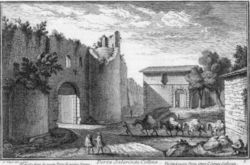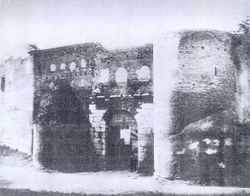
Porta Salaria
Encyclopedia


Gate
A gate is a point of entry to a space enclosed by walls, or a moderately sized opening in a fence. Gates may prevent or control entry or exit, or they may be merely decorative. Other terms for gate include yett and port...
in the Aurelian Walls
Aurelian Walls
The Aurelian Walls is a line of city walls built between 271 and 275 in Rome, Italy, during the reign of the Roman Emperors Aurelian and Probus....
of Rome
Rome
Rome is the capital of Italy and the country's largest and most populated city and comune, with over 2.7 million residents in . The city is located in the central-western portion of the Italian Peninsula, on the Tiber River within the Lazio region of Italy.Rome's history spans two and a half...
, Italy
Italy
Italy , officially the Italian Republic languages]] under the European Charter for Regional or Minority Languages. In each of these, Italy's official name is as follows:;;;;;;;;), is a unitary parliamentary republic in South-Central Europe. To the north it borders France, Switzerland, Austria and...
, demolished in 1921.
History
Porta Salaria was part of the Aurelian Walls built by emperor AurelianAurelian
Aurelian , was Roman Emperor from 270 to 275. During his reign, he defeated the Alamanni after a devastating war. He also defeated the Goths, Vandals, Juthungi, Sarmatians, and Carpi. Aurelian restored the Empire's eastern provinces after his conquest of the Palmyrene Empire in 273. The following...
in the 3rd century, including pre-existing constructions in order to hasten the works. Under it passed the Via Salaria
Via Salaria
The Via Salaria was an ancient Roman road in Italy.It eventually ran from Rome to Castrum Truentinum on the Adriatic coast - a distance of 242 km. The road also passed through Reate and Asculum...
nova, which joined the Via Salaria vetus ("Old Via Salaria") outside the city. The gate had a single passage and was flanked by two semi-circular towers. The Horti Sallustiani were located in the city just inside the gate.
During the restoration by emperor Honorius
Honorius (emperor)
Honorius , was Western Roman Emperor from 395 to 423. He was the younger son of emperor Theodosius I and his first wife Aelia Flaccilla, and brother of the eastern emperor Arcadius....
in the early 5th century, the arch was strengthened in opus mixtum
Opus mixtum
thumb|right|275px|Example of Opus mixtum in the [[Brest Castle]], [[France]].Opus mixtum , or Opus vagecum and Opus compositum, was an ancient Roman construction technique...
, and over it three large windows were opened.
The Goth
Visigoth
The Visigoths were one of two main branches of the Goths, the Ostrogoths being the other. These tribes were among the Germans who spread through the late Roman Empire during the Migration Period...
king Alaric I
Alaric I
Alaric I was the King of the Visigoths from 395–410. Alaric is most famous for his sack of Rome in 410, which marked a decisive event in the decline of the Roman Empire....
entered Rome from this gate to begin the famous Sack of Rome
Sack of Rome (410)
The Sack of Rome occurred on August 24, 410. The city was attacked by the Visigoths, led by Alaric I. At that time, Rome was no longer the capital of the Western Roman Empire, replaced in this position initially by Mediolanum and then later Ravenna. Nevertheless, the city of Rome retained a...
. In 537
537
Year 537 was a common year starting on Thursday of the Julian calendar. At the time, it was known as the Second year after the Consulship of Belisarius...
the area between Porta Salaria and Castro Pretorio
Castro Pretorio
Castro Pretorio is the XVIII rione of Rome. The logo is the golden banner of the Praetorian Guard on a red background. The rione takes its name by the ruins of the Castrum Praetorium, the barracks of the Praetorian Guard, included in the Aurelian Walls....
was the location of the siege
Siege of Rome (537-538)
The First Siege of Rome during the Gothic War lasted for a year and nine days, from 2 March 537 to 12 March 538. It was fought between the defending East Romans, under general Belisarius, and the Ostrogothic army under king Vitiges...
by the Goth king Witigis against the troops of Belisarius
Belisarius
Flavius Belisarius was a general of the Byzantine Empire. He was instrumental to Emperor Justinian's ambitious project of reconquering much of the Mediterranean territory of the former Western Roman Empire, which had been lost less than a century previously....
.
During the Middle Ages, differently from other gates of the city, Porta Salaria did not receive a Christian name.
On September 20, 1870 the trait of the Aurelian Walls between Porta Salaria and Porta Pia
Porta Pia
Porta Pia is a gate in the Aurelian Walls of Rome, Italy. One of Pope Pius IV's civic improvements to the city, it is named after him. Situated at the end of a new street, the Via Pia, it was designed by Michelangelo in replacement for the Porta Nomentana situated several hundred meters...
witnessed the end of the Papal States
Papal States
The Papal State, State of the Church, or Pontifical States were among the major historical states of Italy from roughly the 6th century until the Italian peninsula was unified in 1861 by the Kingdom of Piedmont-Sardinia .The Papal States comprised territories under...
(see Capture of Rome
Capture of Rome
The Capture of Rome was the final event of the long process of Italian unification known as the Risorgimento, which finally unified the Italian peninsula under King Victor Emmanuel II of the House of Savoy...
). The gate was damaged by the artillery fire of the Italian troops, and the following year it was demolished. In 1873, it was rebuilt under design by architect Virginio Vespignani
Virginio Vespignani
Virginio Vespignani was an Italian architect.Vespignani was born in Rome. A student of Luigi Poletti, he was highly interested in classical architecture, becoming one of Roman neoclassical academism's main figures....
.
However, in 1921, it was decided to demolish again the gate to open the area to road traffic. Its area is now occupied by Piazza Fiume ("Fiume square").
Remains
The 1921 demolition uncovered several funerary monuments of the sepulchres that flanked the old Via Salaria and that had been re-used to erect the towers. A copy of the sepulchre of Quintus Sulpicius Maximus, an 11-year-old boy, is now visible in Piazza Fiume (the original is the Musei Capitolini).On right of the walls near the square are remains of 1st-century BC tombs.

